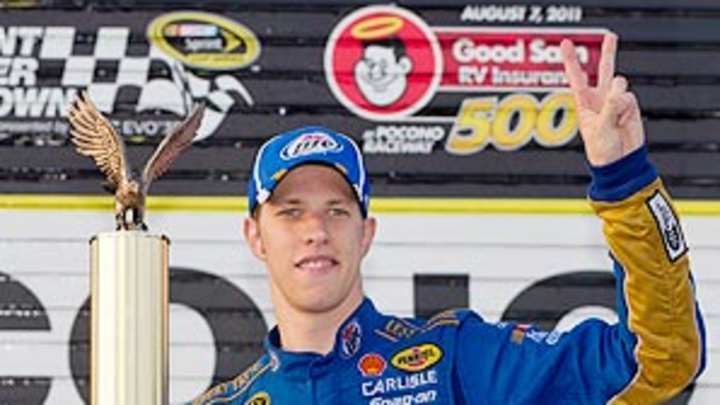Watkins Glen could pose challenge for an injured Brad Keselowski

And competent leaves Keselowski little room for error, considering that, at 18th in points, he is just a three-spot drop from rendering his two wins useless in qualifying for the Chase (only drivers in the top 20 in points are eligible for the wild-card berths).
"He's going to have a tough time this weekend," said Said, who works for Hendrick Motorsports in road course development and will enter the Cup race this weekend. "I don't know if he can push the clutch in. He's a left-foot braker, so there's no way he'll be able to brake with his left foot, and when you brake with your right foot you usually use the clutch on the way down and I can't see him using the clutch, either. He's going to have to be really, really slow and do his downshifts late. I can't believe he raced last weekend. This weekend is going to be a lot harder."
The ballet of foot play so integral on a road course assures that. Although Keselowski nursed a broken left ankle through 500 miles on Pocono's triangular course, he will be much busier in the No. 2 Dodge on Sunday at Watkins Glen. Keselowski could ease the workload of his left foot by shifting without use of the clutch pedal, but the process of "matching revs" to discern the proper time to shift gears is a delicate task even with the durability of modern gear boxes. Braking alone could present an arduous task and Keselowski said on ESPN on Thursday that heat radiating through the floor of the car also causes his foot to swell.
"The biggest thing is you have a lot of heavy braking where you're breaking from 175 [mph] down to like 60 miles an hour," said Said. "On an oval, you break from maybe 200 to 160. [It's] not a lot of braking. And on a road race it changes the structure of the downshift, two or three gears each time. ... There's a delicate balance of braking and downshifting and matching the revs."
At 175 mph "where you brake, within 15 feet, is the difference between making the corner and wrecking in the corner," Said said. "You've really got to be on your game, on your feel to get to 100 percent maximum braking right away. If you're not used to left-foot braking it's really hard. But he's a pretty tough kid, and I think he might figure it out, but it's going to be something to watch."
Pocono Raceway announced on Wednesday that it will shorten both of its Sprint Cup races from 500 to 400 miles beginning next season, a move that had been advocated before the season by several drivers. The move, which was lauded in a statement by NASCAR senior vice president Steve O'Donnell, could signal a series-wide move toward a more concise, ostensibly exciting product that has a better chance at luring and retaining an increasingly fickle marketplace.
Another race that needs to be shortened: the Coca-Cola 600. Now that would be progress, but Speedway Motorsports isn't likely to easily surrender its marathon marquee event.
Jimmie Johnson will contest the Nationwide race on Saturday at Watkins in a rare appearance in the under series, driving in a JR Motorsports entry to promote the release of a new video bearing his name and likeness. Kurt Busch will replace Keselowski in the No. 22 Dodge.
Considering Johnson's and Busch's recent renewal of hostility, the fact points will be of no personal consequence and the numerous close-proximity encounters that are possible on a road course, this could be an opportunity rife with "have-at-it" potential.
Prediction: nothing happens.
Sprint Cup driver Joey Logano will participate in a food challenge on Monday in New York for an upcoming episode of Man vs. Food Nation on the Travel Channel. Logano will not learn of the exact challenge until just before taping. Care for another ghost chili, Joey?
"I am not sure what I have gotten myself into with the eating contest," said the rather wispy 21-year-old. "Best case scenario is I have a large portion of chicken parm, which is my favorite meal. What would not be so good for me is if I had to eat a large amount of beans. Outside of green beans, I am not a fan of the others."
Good for your heart, though. Or so it's said.
Sprint Cup drivers' understanding of road course racing as an exploitable source of points and a greater commitment to capitalizing has made the "road course ringer" a myth, said Said. Barnstorming legend Mark Donohue won at Riverside in 1973, but no other non-Sprint Cup regular has won on a road course since.
"These guys are some of the best racers in the world and I don't think there is a better overall group than NASCAR drivers, and in the beginning they didn't really take road racing seriously," said Said, who was won road course races in a truck and in the Nationwide series. "Once you taught them a few things and they took it seriously, they adapted to it pretty quick. I'd put some of those guys up against the best road racers in the world."
NASCAR regulars have inherent advantages even on road courses, Said said, because of their familiarity with car and crew.
"One, those guys are in those cars week in and week out. They're used to working with their crew," he said. "And guys like me and Ron Fellows come around twice a year and it's really hard to get right at that level. They call us road course ringers, but basically we're just not at as big of a disadvantage like we are when we go to places like Daytona or Talladega or Indy or someplace like that. It just puts us more on a level playing ground but they still have the advantage."
